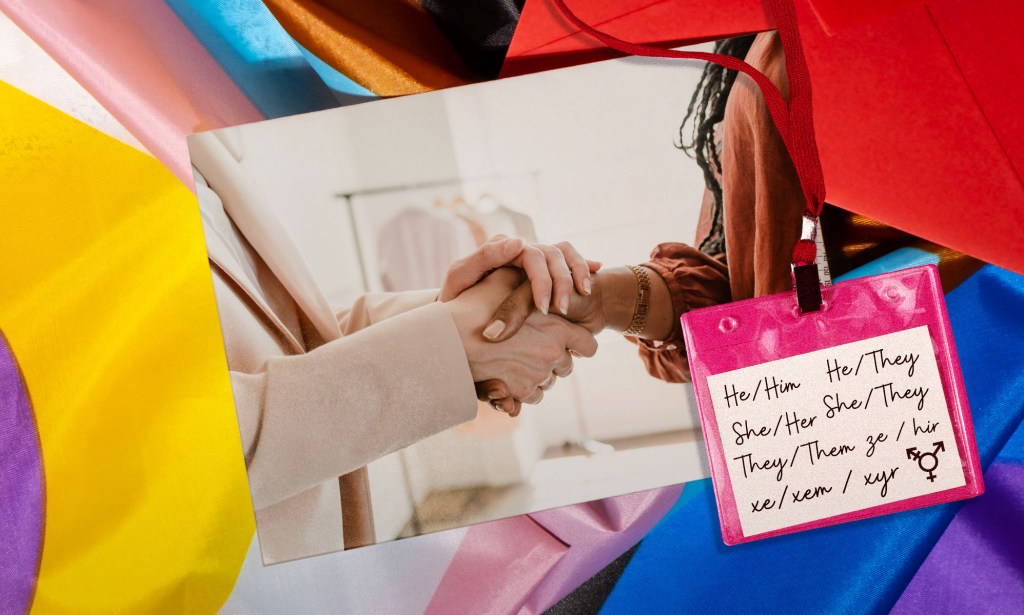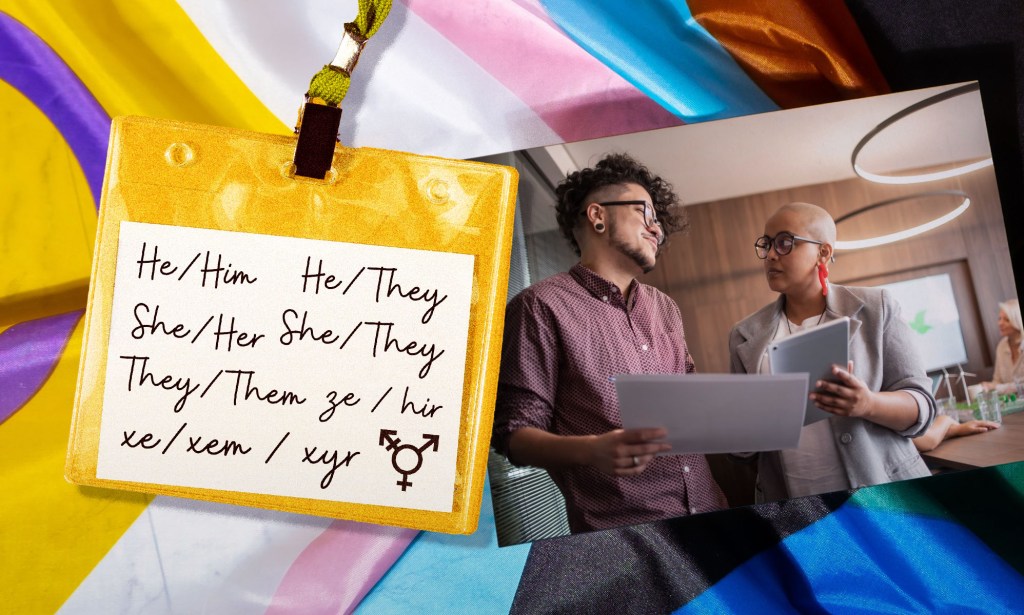Sharing pronouns is a workplace revolution that’s only just beginning

Understanding why employees use pronouns is a key part of workplace inclusion. (Envato/Getty Images/PinkNews)
Trans advocate and inclusive culture expert at SEE Change Happen, Joanne Lockwood, reflects on why the simple act of embracing pronouns can improve inclusion at work.
Most of us believe it is crucial that we make a continuous effort to enhance workplace inclusivity and diversity, but one increasingly important part of that is an understanding and respect of people’s pronouns in the growing movement of pronoun change.
As society and the workforce shift from generation to generation, it’s important to note that what may have been readily accepted for past generations may no longer be the case for Gen Z and Gen Alpha. These generations desire a work environment where they can be their true selves and feel comfortable sharing their sexuality, gender identity, expression, or cultural background. Everyone wants to feel like they belong, and it’s imperative for organisations and leaders to acknowledge and cater to these needs because failure to do so may result in losing top talent to forward-thinking competitors.
Yet companies are still discriminating against people who share their pronouns. I recently heard a case where a company actively rejected a candidate’s application because they had their pronouns displayed on their LinkedIn profile. While many larger organisations openly accept pronouns deliverance, being too overt in your pronouns can still count against you despite being potentially libellous under the anti-discrimination act – even in this case, before they were actually hired.

Gender coding can exclude trans and non-binary people
When taking a global perspective, in some countries being LGBTQ+ might be illegal, so having your pronouns on display can be dangerous – in the same way that gender-neutral passports could potentially create an unsafe travel experience. This might mean that managers don’t put LGBTQ+ employees forward (or they might not put themselves forward) for work trips or certain projects.
You might also have to put your queerness away in a box. When meeting new people or travelling, many of my friends say that they put their non-binary gender identity on hold for a week as it can be too exhausting to explain their pronouns. It is a burden and means that at times, it is not acceptable to be yourself.
There are so many examples of everyday gender coding, from getting in a taxi and assumptions being made that you want to have male-coded conversations about football or “the wife”, to the address of “ladies and gentlemen” at train stations or at conferences. While some surveys offer an ‘other’ alternative which is hardly flattering, most surveys still use the results of the ticked boxes of male or female.
Staff networks are often gender networks that leave out non-binary individuals. I have a friend who was part of a women’s tech group, and assigned female at birth, who came out as non-binary but was then asked not to be a speaker on stage because they had to be female to be accepted.

Why are pronouns in the workplace so important?
Studies have found that using the correct pronouns can help lower depression, improve self-esteem and wellbeing and reduce imposter syndrome, while being misgendered leads to feelings of being invalidated, disrespected and unseen. Positive affirmation can change how you feel in that moment, for the day and going forwards at work.
For many, the rainbow flag you carry around means you are an ally or part of the community. Perhaps pronouns are most valuable for people who are non-binary because of the assumptions people make based on gender through visual perception alone: for example, you may present as female or male but be non-binary or gender fluid or gender non-conforming. Essentially there is no clear definition of what non-binary looks like, and why should there be?
My personal experience was that when I transitioned, I said I didn’t want to share my pronouns, people could just work it out. But I soon came to realise it was about solidarity, like the rainbow flag outside a pub which tells me I know I am safe there.
Still today I have friendship groups who knew me from before I transitioned, and I choose to go on nights out with them fully expecting to be misgendered in some way. It’s not out of disrespect, but old habits die hard. We are still in a societal stage where I suppose I have to accept that if I want to see these friends and they essentially accept me, I must essentially accept their occasional lapse in judgement or speech.
Being an activist 24/7 can be exhausting. My daughter still misgenders me and sees me as ‘dad’ but in this case, the relationship is more important than the language. She isn’t anti-trans but just struggles a bit with her dad being trans.
There are groups who get it right, groups that are clumsy and groups that always get it wrong. Luckily for me, I work in the equity, diversity and inclusion (ED&I) world so generally people get it right, but acceptance can be very industry related.

Is pronoun use in the workplace getting better?
I think we are still building the foundations, but larger organisations generally have the desire to be good employers and/or to be compliant. Having an HR team usually helps. In smaller organisations where there is a less mature HR function, there may still be a way to go based on as and when it happens. Equally, not all big organisations or brands are on board, and they may be Western-based. Even within the West, there may be a cultural blind spot or a poor leader.
Data from a OnePoll survey of 2,036 people found that 23 per cent of Gen Z adults in the UK are now identifying with genderless pronouns (they/them), which means this generation and the next ones are likely to have a huge impact on gender identity over the following decade and beyond. Perhaps we won’t need to transition in the same way, and we will feel less polarised. Perhaps it will become so accepted, that it will equally be less important.
The new generations coming into the workplace are signposting changes in society. To attract this emerging talent, leaders will have to think about their needs especially given there is a talent shortage, otherwise, this talent will give a wide berth to organisations which do not represent their values.
These are some of the best ways to communicate your pronouns at work
- Share your pronouns whether you are cis and an ally who wants to support, or non-binary or trans with lived experience. Check your company values and ethos and what the policy is on naming your pronouns in email signatures and in meetings on Zoom or Teams.
- You don’t have to be a maverick but if you want to, influence policy by finding out who to talk to, offer to draft a policy or be part of a group looking at protocol. Ask the HR team if you can give feedback and suggestions. It shouldn’t be about undermining the organisation or being subversive or in your face – approach these conversations in a positive way.
- Educate your colleagues. Whether that is standing around the coffee machine or on a staff network or forum, explain why you have chosen to share your pronouns – this helps to create a psychologically safe environment.
Did you find this article insightful? Our virtual PinkNews Trans+ Summit is taking place on 11 May and will be jam-packed with more insights and learnings on how to support our trans and non-binary colleagues at work. Find out more about the day-long event and secure your place now.

